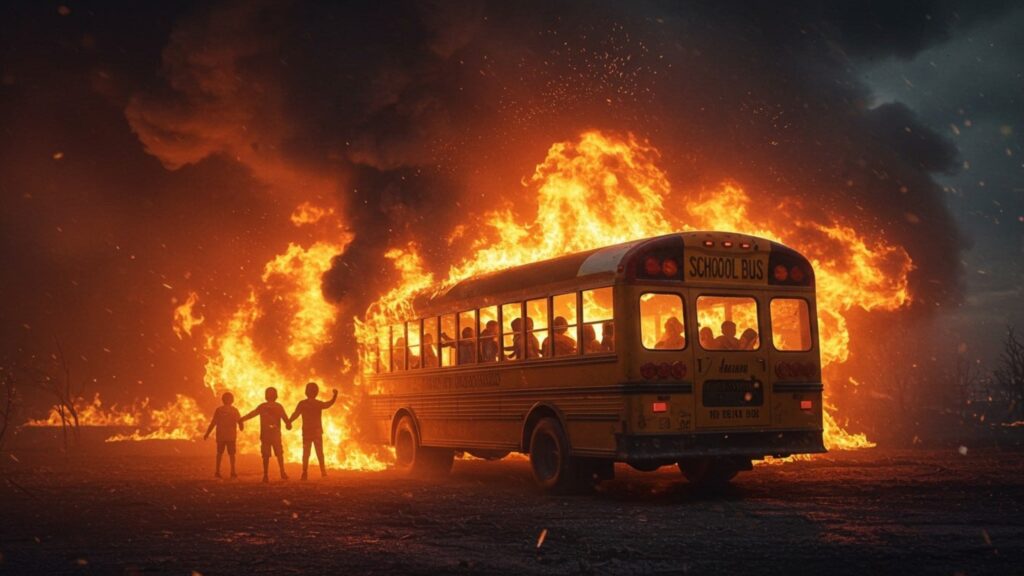Movie Blog — The Lost Bus (2025): Heroism, Heat, and the Price of Survival.
When a disaster film trades spectacle for quiet devotion, it can land somewhere profoundly human — and that’s exactly where The Lost Bus sits. Directed by Paul Greengrass and based on reporting from Lizzie Johnson’s book Paradise: One Town’s Struggle to Survive an American Wildfire, the movie dramatizes a true-life rescue during California’s devastating 2018 Camp Fire. At face value it’s a survival thriller about a bus driver and teacher trying to save 22 children from an encroaching inferno; underneath it’s a study of courage, moral clarity, and the ordinary people who become extraordinary when everything is on the line.
Quick facts you can stash in your head.
Director: Paul Greengrass (co-writer with Brad Ingelsby).
Runtime: ~129 minutes (2 hr 9 min).
Key stars: Matthew McConaughey (Kevin McKay), America Ferrera (Mary Ludwig), Yul Vazquez, Ashlie Atkinson, plus a large ensemble of child actors and supporting players.
Distributor / Platform: Apple Original Films (theatrical release rollout followed by Apple TV+ distribution).
How many cast members — and who carries the The Lost Bus movie?
If you count credited speaking roles and principal players, The Lost Bus features dozens of cast members: the film centers on a handful of named adults (the driver Kevin McKay and teacher Mary Ludwig among them), a supporting circle of townspeople and officials, and roughly 22 child actors who are central to the plot. The cast list on major databases shows a long roll of credited names (from core principals like McConaughey and Ferrera to bit players and extras), which makes sense — the story requires a community to feel real.
As for the “means character” — the central viewpoint or emotional fulcrum — that mantle rests primarily on Kevin McKay, as portrayed by Matthew McConaughey. McKay is the man behind the wheel; the entire film’s moral tension, many of its decisions, and its ultimate heroism are filtered through his actions and perspective. America Ferrera’s Mary Ludwig is the emotional counterpart and co-lead: the teacher who helps keep the children calm and whose own courage amplifies McKay’s. The two-handed performance structure lets the film be both action-driven and quietly human.
Box office and financial footprint.
The Lost Bus is a hybrid creature: a prestige survival drama produced by Blumhouse and Apple that received a theatrical rollout before landing on Apple TV+. Because of that distribution model, box office numbers are not the film’s only measure of success — streaming acquisition and platform engagement matter too. Public tracking sites show the film had theatrical ticketing across North America and international markets and that it has generated meaningful buzz and awards-season chatter, but exact, final global grosses can vary depending on release windows and platform revenue reporting. Industry trackers and reporting articles have catalogued opening grosses and weekend tallies where applicable; in parallel, streaming platform viewership and licensing deals will significantly affect the film’s long-term financial return.
(For readers who want a single number: unlike pure studio tentpoles that live or die by opening weekend, movies like The Lost Bus are judged on combined theatrical plus streaming value and cultural impact — box office is part of the story but not the whole story.)
The niche: what kind of movie is this?
This is a real-time survival drama with documentary DNA. Greengrass — known for a handheld, newsroom-adjacent immediacy in films like United 93 — brings that sensibility here: a grounded, unvarnished eye on panic, small human decisions, and the grinding, terrifyingly slow choices that determine life or death. The Lost Bus film occupies a niche between disaster spectacle and quiet human drama: it’s not about FX-driven spectacle for its own sake; it’s about how ordinary courage looks under impossible pressure. If you like films that place character under pressure rather than focusing purely on pyrotechnics, this is right in that sweet spot.

Deep dive — plot beats, themes, and what makes it work.
The narrative spine
The central incident is simple to summarize but devastating in experience: a fast-moving wildfire engulfs the town of Paradise, California. Roads close, communications break down, and a school bus carrying young children becomes cut off from normal escape routes. Kevin McKay (McConaughey) — an unassuming school bus driver — and Mary Ludwig (Ferrera) — a teacher — improvise a perilous escape, using quick thinking and sheer force of will to shepherd 22 children to safety. The Lost Bus film follows their five-hour ordeal: blocked highways, walls of flame, smoke so thick you can taste it, and the terrifying possibilities as fuel dumps and embers turn neighborhoods into ash.
Structure & tone
Greengrass structures the film as an escalating sequence of micro-choices, each with outsized consequence. There is tension in every steering adjustment, in every call to other drivers, in every decision to go forward when the road looks impassable. The camera stays intimately close; there’s an almost documentary feel to many scenes — not to simulate reportage, but to keep the viewer inside the claustrophobic sensory experience of smoke, heat, and fear. The result is a thriller that rarely resorts to melodrama: it earns its tension through detail.
Performances that carry the silence
Matthew McConaughey invests Kevin McKay with a blend of weary resolve and plainspoken competence; this isn’t a swaggering screen hero, but a man whose life experience primes him to act calmly amid chaos. America Ferrera is the film’s beating human heart: her Mary Ludwig is alternately fierce, exhausted, resolute, and bewildered in the face of so much danger. The chemistry between the two is less romantic and more moral — they are partners in improvisation and care. Critics and interviews have noted how both actors leaned into practicalities (learning bus driving, filming near controlled burns) to make scenes feel tactile and immediate.
Themes: heroism, the ordinary, and collective trauma
A few themes anchor the film:
- Ordinary heroism: The protagonists are not trained first responders; they’re people whose instincts and decency become heroic in extremis. The film resists turning them into mythic figures — their heroism is gritty, small, and human.
- Community and memory: The Camp Fire was not just a headline; it destroyed homes, lives, and a local fabric. The Lost Bus keeps returning to the idea that trauma is collective: the bus isn’t just a vehicle, it’s a vessel of memory for a town that was burned.
- The ethics of survival: The Lost Bus movie asks unglamorous ethical questions — who do you save first, how do you make calls under pressure, and what do you do when options are morally compromised? These are concrete moral puzzles, not philosophical abstractions.
What works — and where the The Lost Bus film stretches
What works brilliantly is the movie’s ability to transform a procedural rescue into a human drama: it’s the small gestures — a wet towel over a child’s face, a whispered lullaby, the decision to drive through smoke rather than wait — that stay with you. Greengrass’s direction and the film’s sound design make the inferno feel palpable. Where the film can feel uneven is in the occasional tug toward dramatization: for narrative urgency, some events are telescoped or heightened; viewers who know the true story can spot those adjustments. But even those choices largely serve to condense a sprawling real event into a watchable, emotionally coherent drama.
Final verdict — who should see it and why.
The Lost Bus is not popcorn escapism. It’s intense, sometimes difficult to watch, and it asks you to sit in the discomfort of people making impossible choices. But for viewers who want films that take human courage seriously—without reducing it to heroics or spectacle—it’s a rewarding watch. It honors the real people behind the headlines while using filmmaking craft to pull you inside the moment. Expect to leave the theater moved, unsettled, and quietly grateful for the ordinary people who become extraordinary in crisis.





